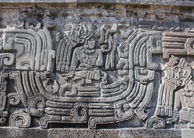Writing: A Necessary Undertaking in Advanced Society
By
2009, Vol. 1 No. 12 | pg. 1/1 Written language is one of the greatest human accomplishments; its formation signifies a breakthrough in human progress. The development of a standardized writing system seems to be a somewhat natural occurrence in the evolution of any given advanced society. It can be observed that, as a culture or a people grow and expand in other areas, an apparent need for written communication arises. There is a transition from a simply widely-spoken and understood language to a designation of a palpable system of letters and symbols which correspond to that language. Therefore, writing is one of a number of indications of a truly complex society. Richard Rudgley, author of Lost Civilizations of the Stone Age, validates this: “writing is, of course, one of the main features of those societies considered to be civilized” (Rudgley: 1999, 15). This contention, regarding the necessity and the resolution of writing, can be seen repeatedly through many examples in prehistory. First, it is appropriate to identify the qualities of an “advanced society.” Basically, the people in a progressing society find something of a common identity. Greenspan and Shanker contest that “for a group to exist, individuals must be able to relate to and engage with one another” and have “the ability… to form relationships (Greenspan and Shanker: 2004, 322, 360). An advanced society is one which possesses intricate functions, one which has made significant contributions in areas such as architecture and agriculture. An advanced society has some designated and somewhat stable ruling power for the benefit of its occupants. It is one that has developed the need for interdependent economies and craft specialists. It is relatively urbanized, or at least those in smaller centers ascribe to the central culture. These are societies in which “not only did abstract thinking in technology and science flourish but so did much more complex social organizations, and there were striking developments in… art, writing, literature… and so on” (Greenspan and Shanker: 2004, 380). Next, it is important to define “writing” and determine how it differs from earlier proto-writing. Writing can be described as “a system of graphic symbols that can be used to convey any and all thought” (Robinson: 2007, 14). It is a widely-established and complex system that all speakers of that particular language can read (or at least recognize as their written language). According to The History of Writing: Script Invention as History and Process, “writing includes both the holistic characteristics of visual perception, and at the same time, without contradiction, the sequential character of auditory perception. It is at once atemporal and temporal, iconic and symbolic” (Robertson: 2004, 19). Writing is clearly more advanced than proto-writing, pictograms, and symbolic communication, which should also be briefly classified. Ice Age signs and other types of limited writing could be designated as “proto-writing.” This type of communication was long before any systems of full writing were developed. In short, proto-writing can involve the use of pictures or symbols to convey meaning. This form of early writing could relate an idea, but the system was not elaborate, complete, or fully evolved. A group of clay tablets from the Uruk period, probably dating to 3300 BC, model these properties of proto-writing (Robinson: 2007, 62). The tablets mostly deal with numbers and numerical amounts; most of the symbols are pictographic in nature. Nothing that could be identified as true writing is evident. So, this form of communication can convey certain concepts well enough, but it isn’t capable of expressing more abstract ideas, nor is it necessarily standardized.So, how did proto-writing evolve into writing? On the whole, how did writing develop around the world, and what were the similarities shared by each occasion? Generally, many of the early societies that exhibit the application of a true writing system indicate that writing was first employed for accounting and economic purposes, to record rituals, to relay messages, and to commemorate the actions of various rulers. These documents note transactions, trade, the names of powerful rulers or officials, etc. In complex society, there are many factors in consideration: population growth, interdependent economies, craft specialization, possibly warfare, the acquisition of new or important knowledge, accomplishments of significant individuals, important exchange and business. These are all reasons that writing was essential—to have a concrete record of things that happened and to provide a bridge between the present and the past. “The advantage of endowing spoken language with permanence through writing allows for the preservation of feelings, facts, and ideas through time and space. This power to conserve… has changed the face of the world. It is a small wonder that such an advantage would prompt the potential of writing to instantiate itself as an omnipresent reality” (Robertson: 2004, 20). In other words, people in these cultures and at different points in history, recognized many long-reaching matters that demonstrated a need for the written word. What were some of these advanced societies, and what do we know about their writing systems? Let us consider Mesopotamia as one of the first complex societies for its contributions in the realm of writing. The later portion of the fourth millennium BC was a time of substantial population increase in Babylonia. During this time, Uruk emerged as the first “true city,” and exhibited an “increasingly hierarchical sociopolitical structure” (Cooper: 2004, 72). The manifestation of artifacts and architecture usually attributed to Uruk at other sites ranging from southwestern Iran across upper Mesopotamia to northern Syria is interpreted as evidence for a strong southern Mesopotamian presence, perhaps even control over these areas. Cooper explains that the level of complexity seen in the social and political aspects of this region led to the use of various means for the improvement of accounting and liability, such as cylinder seals and clay tokens used as counters. In the Uruk IV and III phases, a highly complex accounting system is seen, as well as what is labeled “proto-cuneiform,” which includes an extensive system of logographic and numerical-metrological signs, these phases marking the difference from the earlier tokens, bullae, and simpler seals that were used (Cooper: 2004, 75-6). Cooper states that “for a system of writing with around 900 signs, complex numerical-metrical conventions and intricate bookkeeping formats to be useful, its utilization had to be uniform, necessitating years of more or less formalized instruction” (Cooper: 2004, 76). As time passes and the needs of the society change, it appears that Sumerian writings evolve and become more complex. The writings are an indication of the culture’s progress and level of advancement. This same pattern can be detected in Egypt. Although there are many assumptions that Mesopotamian writing and Mesopotamia’s interaction with Egyptian society helped to stimulate the first writing in Egypt, this is up for deliberation. Rudgley disagrees with the postulation because hieroglyphics represented Mesopotamian writing very little (Rudgley: 1999, 15). John Baines, in his discussion of Egyptian writing, supposes that Egypt developed its own initial writing systems independent of Mesopotamian suggestion or influence. This idea is based on radiocarbon dating of findings in tomb U-j in the royal tomb of Naqada IIIa (Dreyer and Hartung: 1989). Many of the inscriptions found in this tomb are found on small bone and ivory tags which contain hieroglyphs, as well as ceramic jars which display similar markings. The numerals on these tags include single digits in groups of twelve or less, and the hieroglyphic signs represent human figures, various animals, geographical features, and other objects. Scientists have placed dates on the material as possibly concurrent with the Uruk IV tablets, around 3200 BC (Baines: 2004, 153-4). Although the data is difficult to interpret, the system looks as though it is well-formed and diverse. Moreover, these signs point to the utilization of visual culture that had much in common with the progression of writing of later times in Egypt. Günter Dreyer, one of the excavators of tomb U-j in 1989, argues that motivation for the formulation of writing in Egypt was clerical and economic, and that it occurred within a quickly-developing administration (Baines: 2004,163). More specifically, Dreyer contends for a politically-unified Egypt at about Naqada II or c. 3500 BC, with the invention of writing shortly after this (around Naqada IIc). Regarding the findings at U-j, Baines states that “this is the largest and oldest early group of inscribed artifacts so far found in Egypt… [it] is unlikely to have been the first material ever written, and it has prompted excavators to search for earlier antecedents to writing,” reinforcing Dreyer’s conjectures (Baines: 2004, 154). Whether earlier examples are found or not, however, it is observed through this example that Egypt’s culture and its system of writing were closely interrelated China could also be esteemed as a complex society with its need for and development of an early writing system. The earliest known writing of Chinese origin dates to about 1200 BC, from the Shang dynasty, and was discovered at a site known as Anyang in northern China (Bagley: 2004, 190). According to Shi Bo, author of Between Heaven and Earth: A History of Chinese Writing, this early writing is called Jiaguwen, which simply means “writing inscribed on bones and shells”—namely, turtle plastrons and bovine scapulas (Bo: 2002, 13). Divination and answers from oracles were perceived through the cracking of these heated animal bones. The script found on these numerous artifacts demonstrates a very complicated system, with 4,568 identifiable characters that are well standardized (Bo: 2002, 13). Indeed, as Bagley specifies, “a Shang scribe could probably have written pretty much anything he could say” (Bagley: 2004, 198). In this case, writing was used to record questions that the king asked spirits, his interpretation of the omen, and then what actually happened. The mechanism of writing, then, might have first incorporated into ancestor worship and religion. Religious beliefs were connected to the government of the region, since the king (the Anyang samples mentioned are from the reign of Wu Ding) was the one who asked the questions and interpreted the responses (Bagley: 2004, 197). It had a ritual context. Inscriptions from this period are very meticulously recorded, which seems to suggest that at least some of them were intended for display. Robert Bagley proposes that “the audience for [this] display must have been privileged and small. Inscribed objects a foot or so high are not public monuments; the audience they addressed is likely to have been a literate inner circle around the king” (Bagley: 2004, 199). On these grounds, it is assumed that literacy was an important requirement for royals and nobles. It is perplexing, however, that earlier examples, which might reveal phases progressing into to density of the Anyang text, have not been found. Perhaps we cannot see the visible steps because writing before 1200 in China was done on perishable materials that have disappeared. Or perhaps archaeologists simply have not unearthed sites which contain evidence of earlier steps. It is also possible that Chinese writing was a sudden invention, that a few intelligent court officials discovered the principles of phonetic illustration, saw the possibilities of a sign system that could embody language, and expanded on it immediately. With any of those theories, it is still certainly acceptable to contend that, through social and intellectual progress, China recognized the need for a system of writing. The Minoan and Mycenaean civilizations, in their roles in the progression of their writing systems, prove themselves to be advanced. The three early Cretan writing systems are traditionally known as “Cretan Hieroglyphic,” “Linear A” and “Linear B.” At this point, Cretan Hieroglyphic has been found only in Crete; Linear A is confirmed in certain Aegean islands (such as Kea, Kythera, Melos and Thera) and on the Greek mainland; Linear B has been found in the Mycenaean palaces of Knossos on Crete, and Pylos, Thebes and Tiryns (Olivier: 1986, 2). Cretan Hieroglyphic appeared for the last time around 1500 BC, Linear A at around 1450 BC, while Linear B continued to be used on the Greek mainland until around 1200 BC. Although Cretan Hieroglyphic is the first perceived form of written communication in the area, it is regarded as a random arrangement of symbols, and not pure writing. It is an older form of Linear A that seems to demonstrate the characteristics of a true writing system; it was found it the remains of the first palace at Phaistos and is dated to the early eighteenth century (Olivier: 1986, 2). The Mycenaeans, probably around 1800 BC, modified a form of Linear A in order to formulate their own language, Greek. J.P. Olivier, in “Cretan writing in the second millennium BC,” is quick to stipulate that the Minoans themselves did not “re-invent” writing. Instead, with earlier ideas taken from the surrounding areas, “they created an original and astonishingly uncomplicated system for recording the sounds of their language” (Olivier: 1986, 3). With the data obtained thus far, it is most likely that the Minoans developed their writing system in response to economic needs, given the simultaneous building of the first Cretan palaces (1900-1625 BC). The script here represented not only the syllables of the language(s); it also comprised a very simple method for the representation of numbers, based on a decimal system. In the time of the second millennium, Mycenaean culture expanded into other parts of the Aegean and Greek and Anatolian mainlands. There is evidence for a thriving economy and wealth in this period. Crete’s society, through these cultures, again demonstrates the need for writing as society becomes more multifaceted. As Jerrold S. Cooper words it, “Many scholars would be happy with the proposition that Sumerian, Egyptian, Chinese, and Maya were all created in response to local needs… [it] was a response to increasing social and political complexity” (Cooper: 2004, 71). These societies, as well as others discussed, recognized the necessity of the written word as they grew more complex and changed their focus. Writing was one of many functions that helped these societies progress. Without it, there would be no historical record or literary contributions from any previous peoples. Through writing, noteworthy cultures around the world painted a picture of their culture. They related their conquests and their ruler’s feats, their knowledge, their interactions with the world around them, their daily lives. The implementation of writing in a society’s history indeed marks progress through change for not only the society itself, but for mankind. ReferencesBagley, Robert W. 2004. Anyang writing and the origin of Chinese writing. In The First Writing: Script Invention as History and Process, edited by Stephen D. Houston, pp. 191-250. Cambridge University Press, New York. Baines, John. 2004. The earliest Egyptian writing: development, context, purpose. In The First Writing: Script Invention as History and Process, edited by Stephen D. Houston, pp. 150-189. Cambridge University Press, New York. Cooper, Jerrold S. 2004. Babylonian beginnings: the origin of the cuneiform writing system. In The First Writing: Script Invention as History and Process, edited by Stephen D. Houston, pp. 71-99. Cambridge University Press, New York. Greenspan, Stanley I. and Stuart G. Shanker, D. Phil. 2004. The First Idea: How Symbols, Language, and Intelligence Evolved from Our Primate Ancestors to Modern Humans. De Capo Press, Cambridge. Olivier, J.P. 1986. Cretan Writing in the Second Millennium BC. World Archaeology Vol. 17, No.3, pp. 377-389. Robertson, John S. 2004. The possibility and actuality of writing. In The First Writing: Script Invention as History and Process, edited by Stephen D. Houston, pp. 16-38. Cambridge University Press, New York. Robinson, Andrew. 1995. The Story of Writing: Alphabets, Hieroglyphics, and Pictograms. Thames and Hudson, New York. Rudgley, Richard. 1999. The Lost Civilizations of the Stone Age. Touchstone, New York. Suggested Reading from Inquiries Journal
Inquiries Journal provides undergraduate and graduate students around the world a platform for the wide dissemination of academic work over a range of core disciplines. Representing the work of students from hundreds of institutions around the globe, Inquiries Journal's large database of academic articles is completely free. Learn more | Blog | Submit Latest in Anthropology |
















